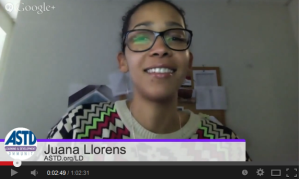This is THE number one question I get asked.
People who attend storytelling teleseminars, webinars, and seminars get it that storytelling is powerful, but… don’t know where to find stories.
The short answer is…stories are everywhere, all the time.
If you pay attention and know what to look for, you can extract cool teaching stories out of everyday life.
For a longer answer and more “how to’s” sign up for the upcoming Google Hangout I’ll be doing with Juana Llorens of ASTD on Friday at 2 PM ET (no worries if you can’t make it live, you can download later), but…what I would love for you to do IF….you want some free coaching from moi, is to:
Post a question or better still…describe a key teaching point or take away message you often communicate in your presentations that you would like to come up with a story to illustrate, and….
I will pick the best ones to use as illustrations…i.e. I will share my thought process in how I come up with stories and analogies.
How cool is that? 🙂
Here’s the link:
https://plus.google.com/u/0/events/c2gq97qk497jo8gkv4okg3rvg30
Now…in the meantime, read on for more quick how to tips:
Colin from Ontario posed this question to me when he signed up for the upcoming “Wrap Your Message in Bacon” webinar.
Thanks for the question Colin.
Here’s my answer…actually answers…
1. Practice Mindfulness–Pay attention to all of life, even those simple, “ordinary” moments that offer a potential lesson, remind you of some important principle, surprise you, amuse you, or make some kind of emotional impact.
2. Practice Thinking in Analogies–I’ll be teaching this in depth in the upcoming storytelling webinar series, but for now, practice thinking “Hmmm…what’s this like?” “What can this be an analogy for?” whenever you experience something interesting.
3. Write Down Your Thoughts As Soon as Possible–This is huge, especially with “Constructive Conversation” stories where the actual words you used are an important part of the story and are quickly forgotten. As I mentioned in the ASTD webinar, I use a simple, two column Word table with a story per row. The left column is for searchable key words or phrases and the right with narrative, so I can recall the story later.
4. Practice, Practice, Practice–After doing this for over 20 years, my brain has become a story-catching, analogy-recognizing machine :-). It just comes naturally now, just like it will for you if you work at it. A good friend of mine, after taking an NLP and storytelling seminar from me 15 years ago, told me at the time that she wasn’t good at thinking in analogies because her medical training had so oriented her toward analytical, “no nonsense” thinking, she felt she had lost the more right-brained, analogy-noticing and analogy-creating ability. Now, years later, she is an amazing analogy-creator.
Five Recent Story or Analogy Finding Examples…
So…let me give you some examples of stories that came into my life (or awareness) in the last few days:
1. This week I had a really positive coaching session with a manager who had made excuses for not delivering on her responsbilities on several occasions–i.e. she used the “I was so busy” as an excuse for not doing what she was supposed to do.
I struggled with how to confront this in a way that wouldn’t trigger defensiveness, but still have her look at this behavior. I was feeling very judgmental and had to do some serious work to get to compassion and non-judgment. We ended up having an amazing, honest conversation about this. This will be one of my Let’s Talk for a Change seminar stories in the future.
2. One of my dear friends sent me an inspirational video this morning. I thought…”Hmmm…what’s the lesson here that we all can use?” and posted the video and a bit of narrative at my WhateverLifeBrings.com site.
3. When I tried to post the link on Facebook, I was notified that my password was wrong. I had just changed it and had forgotten what it was. When I went to open my email account to get the link to reset it, I discovered I had forgotten that password, too (I had just changed that also). I found myself thinking “Hmmm..what’s this like?” One analogy that came to mind was ‘My operational inefficiency was hampering my creative output”. That made me think of how I could use it as a simple analogy in the future for how a business’s or a solopreneur’s lack of organization, or efficient processes can seriously hamper their innovative ability and productvity.
4. I heard someone remark about the upcoming election: “This is going to be the opportunity for Americans to decide whether we want to be a nation of children or a nation of adults”, referring to his perception that as a society we seem to be wanting government to take care of us, remove all risk from life, tell us what to do, etc. It made me think about how often “old school” command and control, “We think, you just do your job” management and organizational practices often lead to a “childified” wokforce that isn’t willing to think for themselves and demonstrates child-like behaviors–like gossiping, blaming, focusing on what their employer can do for them rather than how they can provide value. So…his remark made me think of the corollaries beteween a parental organization and a parental government, and what they elicit in “the masses.”
5. Another manager I was coaching yesterday shared her struggle as a new manager coming into a team that is very set in their ways and how they bristle at her suggestions. We are going to continue working on it today. It will be a really useful teaching story I can use in upcoming seminars and articles.
So, you see…stories are everwhere. You (we) just need to practice being mindful, ask “Hmmm…what’s this like?” and “What lessons does this teach?” and write it down ASAP.
Thanks for your question Colin. Hope this helps.
Again, the Google Hangout link is:
https://plus.google.com/u/0/events/c2gq97qk497jo8gkv4okg3rvg30
Sign up and post your key take away point or question you would like me to work with.
 Here’s a 30 minute video recorded a couple of years ago, that will give you examples and ideas of how to be on the lookout for everyday life experiences you can use as stories in your presentations and sales conversations.
Here’s a 30 minute video recorded a couple of years ago, that will give you examples and ideas of how to be on the lookout for everyday life experiences you can use as stories in your presentations and sales conversations.

